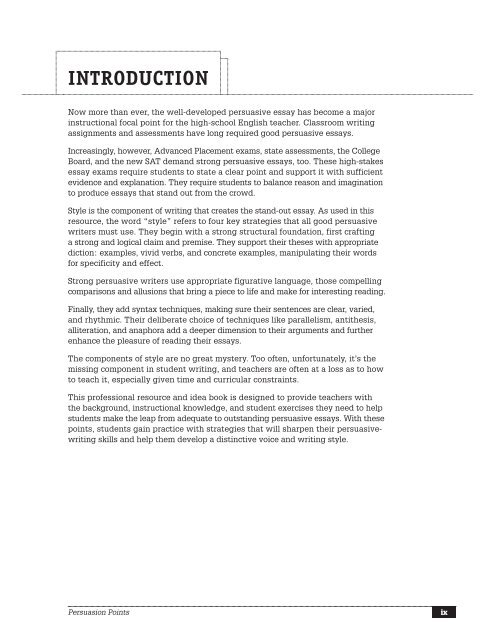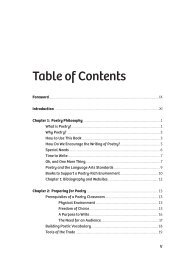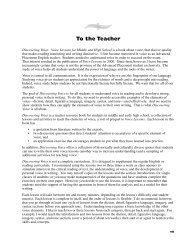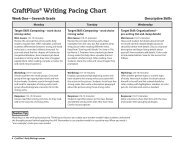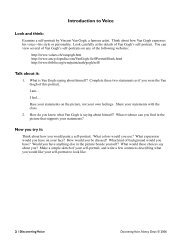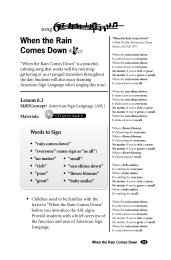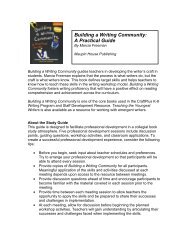INTRODUCTION - Maupin House Publishing
INTRODUCTION - Maupin House Publishing
INTRODUCTION - Maupin House Publishing
You also want an ePaper? Increase the reach of your titles
YUMPU automatically turns print PDFs into web optimized ePapers that Google loves.
<strong>INTRODUCTION</strong><br />
Now more than ever, the well-developed persuasive essay has become a major<br />
instructional focal point for the high-school English teacher. Classroom writing<br />
assignments and assessments have long required good persuasive essays.<br />
Increasingly, however, Advanced Placement exams, state assessments, the College<br />
Board, and the new SAT demand strong persuasive essays, too. These high-stakes<br />
essay exams require students to state a clear point and support it with sufficient<br />
evidence and explanation. They require students to balance reason and imagination<br />
to produce essays that stand out from the crowd.<br />
Style is the component of writing that creates the stand-out essay. As used in this<br />
resource, the word “style” refers to four key strategies that all good persuasive<br />
writers must use. They begin with a strong structural foundation, first crafting<br />
a strong and logical claim and premise. They support their theses with appropriate<br />
diction: examples, vivid verbs, and concrete examples, manipulating their words<br />
for specificity and effect.<br />
Strong persuasive writers use appropriate figurative language, those compelling<br />
comparisons and allusions that bring a piece to life and make for interesting reading.<br />
Finally, they add syntax techniques, making sure their sentences are clear, varied,<br />
and rhythmic. Their deliberate choice of techniques like parallelism, antithesis,<br />
alliteration, and anaphora add a deeper dimension to their arguments and further<br />
enhance the pleasure of reading their essays.<br />
The components of style are no great mystery. Too often, unfortunately, it’s the<br />
missing component in student writing, and teachers are often at a loss as to how<br />
to teach it, especially given time and curricular constraints.<br />
This professional resource and idea book is designed to provide teachers with<br />
the background, instructional knowledge, and student exercises they need to help<br />
students make the leap from adequate to outstanding persuasive essays. With these<br />
points, students gain practice with strategies that will sharpen their persuasivewriting<br />
skills and help them develop a distinctive voice and writing style.<br />
Persuasion Points ix
WhAT yOU’LL FIND IN ThIS BOOK<br />
Part I (Chapters 1-12) presents the writing strategies individually, with instructional<br />
notes and student exercises and reference sheets. Part II (Chapters 13-15) gives you<br />
tools to help students apply their practice to draft, revise, and edit their essays. Part<br />
III deals with problem-solving and assessment and includes student practice with<br />
scoring several essays against a rubric. Also in Part III are additional skill-sharpening<br />
games and activities for the whole class, some questions for close reading, a glossary<br />
of terms, a quiz on the terms, and 101 writing prompts. Together, this resource<br />
presents a metaphorical Swiss Army knife of writing strategies that you and your<br />
students can use to tackle any writing task with confidence.<br />
In Part I (Chapters 1-12), each chapter begins with an explanation, followed by<br />
reproducible student activities and worksheets that provide definitions, examples,<br />
and practice. “Teaching Notes and Answers” at the end of each chapter provide you<br />
with instructional information, examples, and activity answers.<br />
A Style Points Quiz with answers follows Chapter 12 as a culminating assessment<br />
activity. Use this assessment to guide instruction and assess understanding.<br />
Part II (Chapters 13-15) focuses on helping your students apply their style-points<br />
practice to the essay-writing process. Chapter 13 includes a powerful pre-writing<br />
strategy, summaries of the major points, two student-revision strategies, and ways<br />
to help your students edit for coherence and organization.<br />
Chapter 14 provides you with problem-solving and assessment information to pinpoint<br />
problems and to give your students practice scoring an essay against a provided sixpoint<br />
rubric. Finally, additional whole-class games and activities in Chapter 15 add even<br />
more effective spice to your instruction. The “Resource” section also provides you with<br />
101 writing prompts and a glossary of key terms, along with a final quiz that tests their<br />
knowledge of the terms you’ve taught.<br />
An important organizational note: After you assess the worksheets, return them<br />
to the students for reference. Students can keep them in a binder or portfolio. This<br />
allows them to track their progress, review past strategies, and return to past drafts<br />
for revision. It will be especially helpful as they bridge the transition from learning<br />
and practicing Part I writing strategies to applying those strategies in Part II essays.<br />
x Introduction
hOW TO USE ThE STyLE POINTS LESSONS<br />
IN yOUR CLASSROOM<br />
Because the needs of teachers (and their students) vary so widely, this book<br />
is designed to give you as much flexibility as possible. Here are two basic approaches<br />
you might take.<br />
Option 1: Go through the book’s exercises in sequence. The student lessons in the<br />
first twelve chapters are cumulative: They progress from introductory exercises that<br />
introduce each strategy to short composition activities in which students apply each<br />
strategy in their own writing.<br />
Each of the student worksheets contains some background definitions, examples, and<br />
explanations. But you will get the best instructional results if you introduce and teach<br />
the lesson first. The notes in the beginning of each chapter give you ideas of how<br />
to introduce and teach each concept that the students will work on.<br />
Additionally, the “Teaching Notes and Answers” that follow each chapter provide you<br />
with specific instructional tips and information that applies to each exercise, as well<br />
as examples, definitions, and student-worksheet answers.<br />
As you lead students through the lessons’ concepts, focus on the examples and models<br />
provided to help you. Take time to read these aloud with students so they can see the<br />
strategies in action before they do their own writing.<br />
Allow at least one class period (forty–fifty minutes) for each activity. Using this approach,<br />
the first part of the book will take at least twelve weeks to complete (more if you<br />
do every activity in each chapter).<br />
Once students have completed Part I of the book, Part II will guide them through the<br />
process of applying the strategies by writing fully developed essays. The activities<br />
in Chapter 13 support students throughout the entire writing process: pre-writing,<br />
drafting, revising for coherence and organization, and self- and peer-revision.<br />
For the first essay you assign, spend at least one class period on each activity to ensure<br />
that students are well-grounded in each stage of the writing process. This groundwork<br />
will pay off later, as it equips students with strategies they can use at each stage.<br />
The whole-activities in Chapter 15 are designed to reinforce the strategies learned<br />
in Part I; these can be used at any time to practice and sharpen students’ use<br />
of these strategies.<br />
Option 2: Jump around based on the needs of your students. Each chapter in this<br />
book is self-contained so that you can use it individually out of sequence. If, for example,<br />
your students need work on verbs, use the activities in Chapter 3. For planning purposes,<br />
each activity is designed to take approximately one forty- to fifty-minute class period.<br />
Chapter 14 provides a section on “Pinpointing Problems,” which will help you identify<br />
specific strategies that you might teach based on past student-writing assessments.<br />
Because no two teachers use any one book the same way, this book is designed so that<br />
you can flip back and forth between Part I and Part II based on your preferences and<br />
needs. The Chapter 15 activities are the one exception; these activities, which provide<br />
whole-class options for practicing and reinforcing skills, presume knowledge of the<br />
strategies from Chapters 1-12.<br />
Persuasion Points xi


